-
EngineTwin-Turbo 3.8L V8
-
Power641 HP / 500 LB-FT
-
Transmission7-Speed DCT
-
0-60 Time2.9 Seconds (est.)
-
Top Speed204 MPH
-
DrivetrainRear-Wheel Drive
-
Curb Weight3,250 LBS (est.)
-
Seating2
-
Cargo6.9 CU-FT
-
MPG20 combined (EU cycle est.)
-
Base Price$280,225
Though the 650S essentially takes what was offered in the original MP4-12C, pumps it all up and refines it nicely, this new member of the McLaren clan looks more like a P1, albeit one costing over three-quarters of a million dollars less than the real deal. Truth be told, 12C production ceased in January to allow 650S production to ramp up, and the new car will therefore serve as McLaren's entry-level model until its rumored Porsche 911- and Aston Martin V8 Vantage-rival comes along.
There were a handful of key things we hoped for in this new 650S: more power and torque than the 12C, a more finely tuned ride and handling balance no matter the H (handling) and P (powertrain) setting selected, more character from the bi-turbo V8's exhaust and a flashier, less banal design.
We're pleased to report that all of these issues have been addressed.

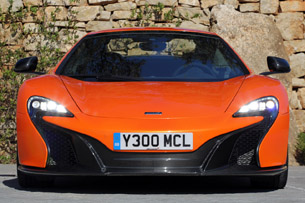
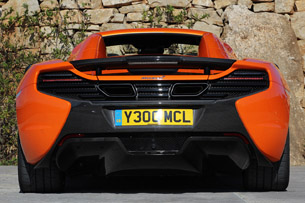
The 650S' naked chassis and powertrain are nearly identical to those of the 12C at first glance, but variations do exist. The entire top portion of the dry-sump M838T 3.8-liter V8, built up by engine kings Ricardo in the UK, has been reengineered for more urgency and less friction between moving parts. These developments lead to microscopically improved fuel efficiency and lower CO2 numbers. Similarly, the seven-speed Seamless Shift Gearbox (SSG) from Graziano is the same unit, but its software has been reprogrammed for better shift behavior both in-town and at full chat come track days.The 650S' chassis and powertrain are nearly identical to the 12C, but variations do exist.
Whereas on the 12C, Pirelli PZeros have been standard-issue tires with Corsa versions as an option, the 650S jumps straight to the latter's higher-performance asymmetric treads. As to braking, there is a similar change, with the optional Akebono carbon-ceramic brakes of the 12C coming standard on the 650S.
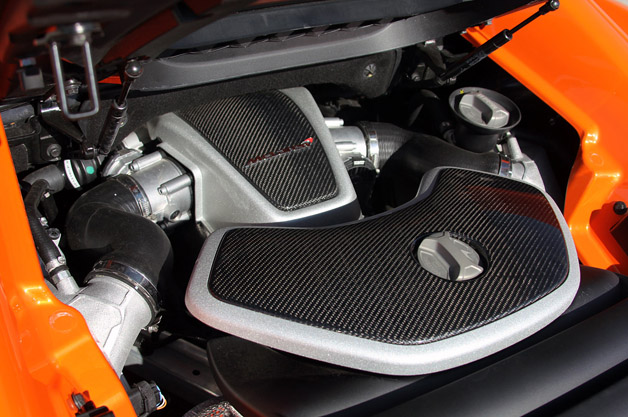
With that new-look, P1-style front end gobbling up more air, at 150 miles per hour, downforce is increased by 40 percent over the 12C's less extravagant nose. Larger engine-cooling side scoops are now visibly rendered in carbon fiber – our test car was equipped with the full carbon-look exterior detailing. To compensate for this much higher downforce that allows quicker lap times, the ProActive Chassis Control suspension scheme has come in for tweaking, too.The entire top portion of the 3.8-liter V8 has been reengineered for more urgency and less friction.
The revisited system on the 650S employs wider-diameter dampers with bigger pistons, plus an accumulator attached to the damper body that manages hydraulics – a setup similar to that of the P1. The result is much tighter control of all dynamic movements under all conditions. Add a higher spring rate at the rear to liven up directional changes – something that at times on the 12C felt almost soft even though you knew the hardware was working – and the driver simply senses more faithful feedback. All that leads to improved confidence in every corner and transitional moment.
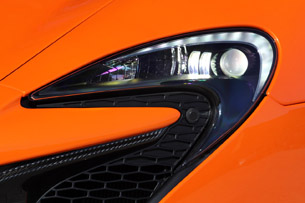
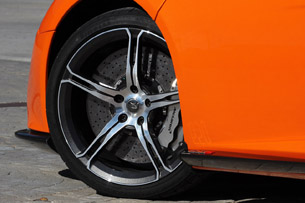
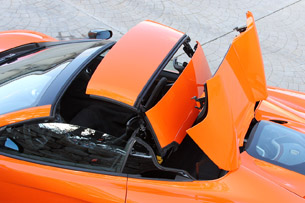
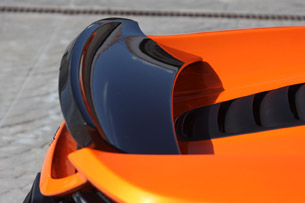
We gave this new 650S a proper thrashing around the 3.4-mile Ascari circuit. The sensation fostered by the 616-horsepower 12C – especially when pushed on a track – was always that the car would go about its business methodically and competently, but with little flair and a slight lack of solid feedback. The ProActive chassis worked so hard on the 12C that it ended up giving the driver a less-than-complete idea of exactly how fast they were going, as well as how fast they could go. The dampers and springs and steering also came off as a little under-communicative. It all worked very effectively, but a progressive crispness and a more talkative chassis was needed in order to more regularly knock our socks off the way the Ferrari 458 Italia and Porsche 911 GT3 have routinely managed.We gave this new 650S a proper thrashing around the 3.4-mile Ascari circuit.
This 650S goes a long way toward addressing these shortfalls. Now at 641 horsepower and 500 pound-feet of torque (up nine percent) and incorporating all of the aforementioned technical upgrades, the 650S is the Ferrari 458 Speciale of 12Cs, if you follow us. Its chassis and gearshifts are exactly as they should be now, whether you have the powertrain and handling set to Normal, Sport, or Track. We tested all three calibrations on both twisting roads and on countless laps of Ascari, and everything is quicker yet smoother, with more feedback. Most importantly, the 650S delivers these improvements with a much clearer sense that the driver is at the heart of the experience, not the technology. Steering turn-in has been especially improved on the 650S' electro-hydraulic rack, and the already exceptional brake-steer system (which slows the inside rear wheel in corners to curb understeer) has been carried over from the 12C.
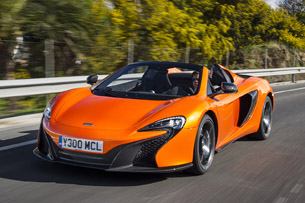
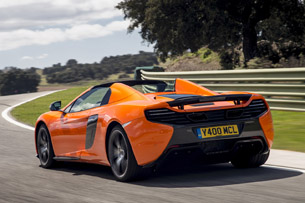
The difference brought about by the stiffer Pirelli PZero Corsa tires and Formula-One-quality carbon ceramic brakes cannot be overstated. With more time on the track and in these ideal dry conditions, we would have loved to have eagerly explored this exceptional equipment further. In another very positive development, McLaren has also altered the 650S' braking software to make pedal feel and engagement more linear and less like an on/off switch.The difference brought about by the Pirelli PZero Corsa tires and F1-quality carbon ceramic brakes cannot be overstated.
With the P dial set to Track mode, when at 5,000 rpm or greater, there's more torque delivered in every gear as you upshift under hard throttle. This is being called "inertia push" – as we will see on the Lamborghini Huracán – and on Ascari's three key straighter sections of track, it's an emotional development, similar to what the P1's IPAS button performs through that car's electric motor. Only here, there are no extra buttons to push to get it. The same is true of the Drag Recovery System that works at high speeds to decrease the drag provided by the rear AirBrake wing. It's an easier-to-use, P1-inspired set of technological tricks on a smaller budget.
We also prefer the updated, P1-influenced styling penned by design director Frank Stephenson and his team. There is much more of a fanciful spirit going on – the 12C is a svelte thing, but it also is a bit anonymously styled, particularly up front. The 650S is decidedly more interesting to look at. It's also fun to watch the top retract, as can be seen above.
Sitting in the 650S also provides a much more personalized cabin than that of the short-lived 12C. There are now more options available and the exterior gets four dedicated colors. This particular orange – McLaren's third – is named Tarocco after a blood orange in Spanish, and there's a new blue, a gray, and a green as well. Our test car featured available race seating covered in synthetic ultrasuede that, among other things, will have you religiously dieting in a jiffy.
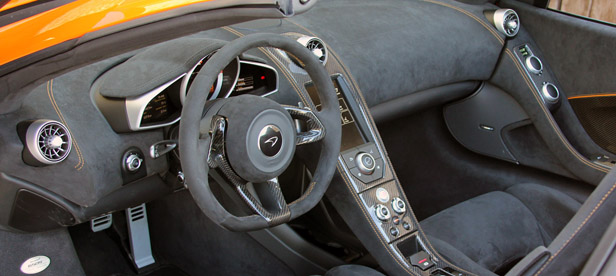
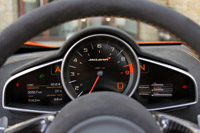
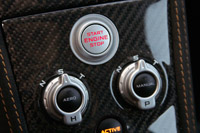
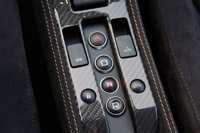
They might be tight, but this optional furniture is just the thing for testing out the 650S' impressive performance numbers. The official estimate of 2.9 seconds to 60 mph feels conservative, and this new Mac will storm all the way up to 204.It doesn't take a tunnel to reveal that the 650S doesn't have the operatic lungs of a Ferrari.
The 12C's exhaust sound saw countless unfortunate comments hurled its way during its brief life. Revised for this model, it's sort of better now, but again, it's really heard largely outside – inside, this car is still too quiet. Even in this Spider configuration with roof open and the little rear window down, it doesn't take a tunnel to reveal that the 650S doesn't have the operatic lungs of a Ferrari. To be fair, though, McLaren doesn't seem to be trying to compete on this front. The British racing outfit has at least engineered a two-cylinder cutoff on downshifts that announces your approach to any Spanish village with festive, uppity throttle blips.
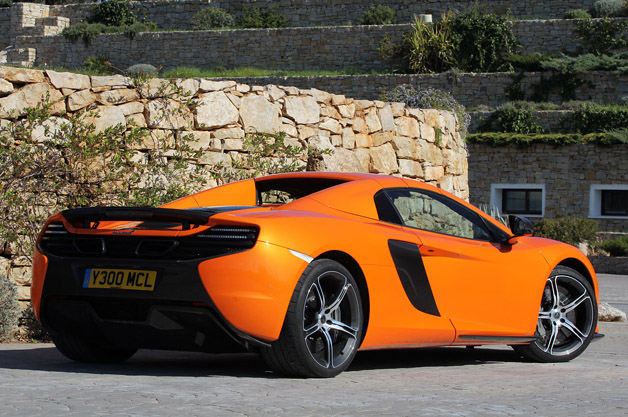
For the Spider's roof system, count seventeen seconds to either open or close the fairly simple design. Nothing has changed here from the 12C Spider, and we still think this is the best mechanism of its type on the market. Leisurely rich folk on the go can raise or lower the roof at speeds up to 19 mph, too. Ahh, the joys of slow-speed multitasking.
As on the 12C Spider, the torsional and bending rigidity for the 650S Spider is identical to the coupe thanks to the stiffness of its aluminum and carbon-fiber chassis and passenger tub. It's just one more reason to not feel obliged to go for the coupe bodystyle if you want to do track days.The 650S offers up a comprehensive re-think of Mac's 12C.
The 650S offers up a comprehensive re-think of Mac's 12C that took the world by storm just a few years ago. This is progress of a variety that we can really appreciate, as can the buyers. After all, ninety percent of McLaren's American customers can't be wrong.
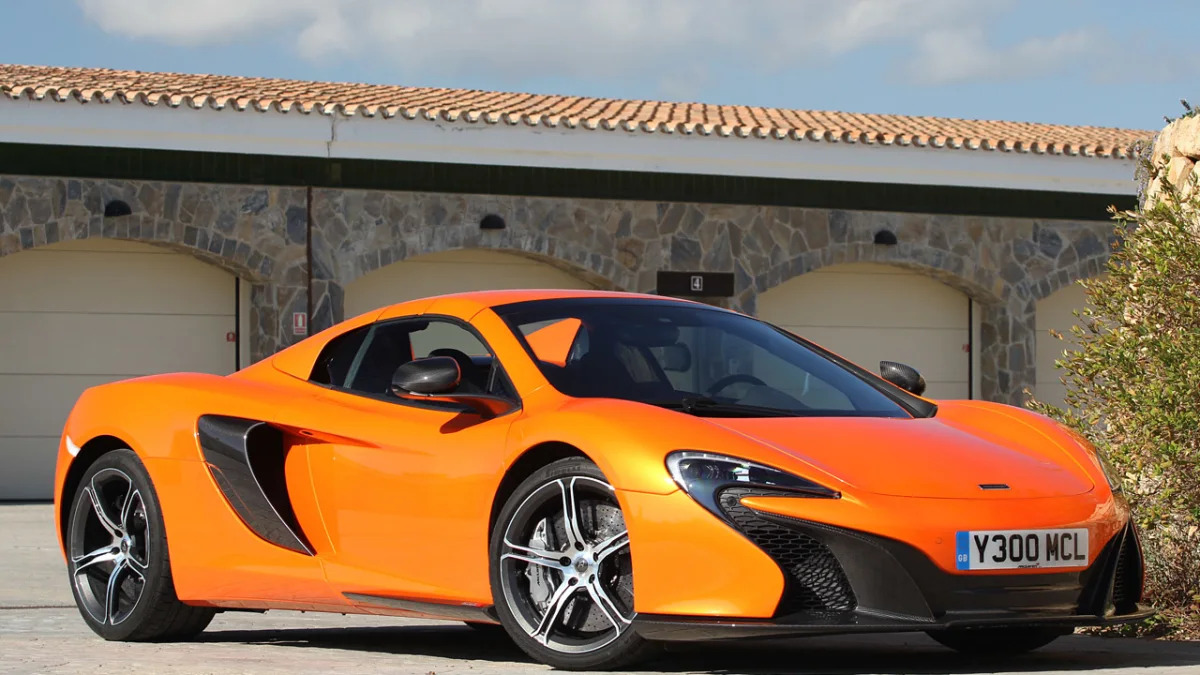









Sign in to post
Please sign in to leave a comment.
Continue